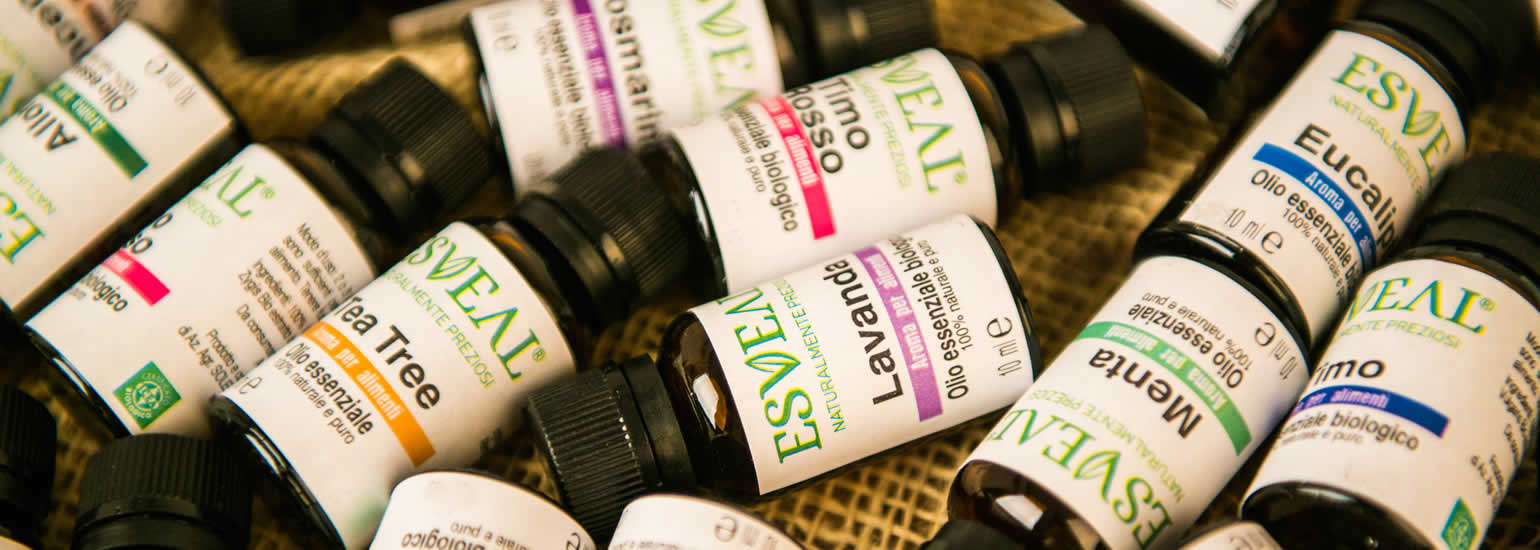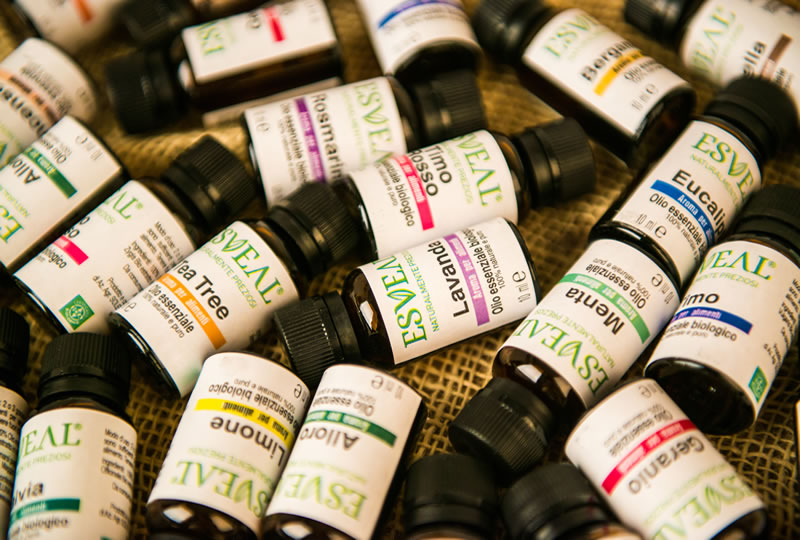
ORGANIC ESSENTIAL OILS
EUCALYPTUS, LAVENDER, LEMON, ROSEMARY, SAGE, THYME.
EUCALYPTUS, LAVENDER, LEMON, ROSEMARY, SAGE, THYME.

.
You can buy our essential oils with the confidence that you have chosen the best essences, which have always been known for their many important beneficial properties. Our commitment to the quality and purity of our organic essential oils is reflected in every drop of the oils we offer.
Esveal essential oils are extracted using the 'steam current' method, a gentle process that preserves all the extraordinary properties of the plants, guaranteeing a final product of the highest quality. Citrus essential oils are extracted by squeezing, the best extraction method to ensure maximum freshness and vitality of these essences.
All our oils are sourced solely from organic cultivation, thus supporting a model of sustainable, environmentally friendly agriculture. This ensures that each bottle of Bio essential oil contains only the purest and most natural essence, without the use of pesticides or harmful chemicals. Characterised by their exceptional purity, they are also suitable for food use. This means you can enrich your culinary preparations with a touch of pure nature while benefiting from their unique health properties. Whether for flavouring a cake, tea or dish, or for any other use, Bio Esveal essential oils are an easy way to integrate the benefits that only nature can offer into our daily lives. Discover the organic purity of Esveal essential oils and be enveloped in their extraordinary natural and health-giving qualities.

Free shipping costs for amounts over €170.
Essential Oil from Organic Agriculture
Essential Oil from Organic Agriculture
Essential Oil from Organic Agriculture
Essential Oil from Organic Agriculture
Essential Oils from Organic Agriculture
Essential Oil from Organic Agriculture
Essential Oil from Organic Agriculture
Essential Oil from Organic Agriculture
Related Topics : Good conservation practices for essential oils - characteristics of essential oils - Aromatic waters - Methods of extraction of essential oils - Organic essential oils - Essential oils and astrological functions - Essential oils and olfactory notes - Eucalyptus essential oil - lavender essential oil - lemon essential oil - rosemary essential oil - sage essential oil - thyme essential oil - Operational practice in the extraction of essential oils - Purification and rectification of essential oils - Yield in the extraction of essential oils - Use of essential oils
The use of medicinal plants can be said to be as ancient as man. Essential Oils (or Essences, or even Volatile Oils or Ethereal Oils) are complex mixtures of organic substances of various chemical nature contained and extracted from plants. The use of medicinal plants can be said to be as ancient as man.
in prehistoric times...
Among the most ancient testimonies are those of the Chinese dating back to 8,000 BC and the Sumerian civilization of 5,000 BC. In countries such as China, India or Persia, the distillation of plants and the use of Essential Oils was in use.
in ancient history...
The Egyptians knew the distillation to obtain Essential Oils and taught it to the Greeks who, in turn, began it to the Romans. It seems that the Egyptians were able to prepare an Essence of conifer forty centuries before our Era in this way: on the opening of a clay pot, which was heated with cedar wood, was placed a gridiron of wool fibres; then the wool was compressed to release the essence with which it was going to be impregnated.
in less ancient history...
The Ancients were unknown to the Active Principles of the Essential Oils, but they knew their healing properties and that was enough for them. It is very probable that the Ancients had some much more acute sensory abilities than we modern men have. The Arabs discovered plant distillation in the Middle Ages.
Around the 13th century the nascent pharmaceutical industry favored the development of distillation. In the 16th century, the industry produced in Provence the Essences of lavender and sprig (a type of lavender). In the 15th century, the aromatic essences of bitter almonds, sprig, cinnamon cedar, incense, juniper, mastic, rose and sage were known. A century later, about sixty additional essences were discovered, including those of angelica, anise, orange, absinthe, basil, bryony, bryony, chamomile, cardamom, caraway, coriander, cumin, fennel, lavender, lemon, mace, marjoram, mint, myrrh, myrrh, oregano, pepper, parsley, savory, sassafras, celery, serpillus, tanaceto, thyme, saffron, ginger.
At the beginning of the 17th century, with the Essences of mugwort, bergamot, boxwood, cajeput, chervil, cypress, neroli, pine, sabina, mustard, thuja, valerian and many others, most of the useful Essences of Europe and the Near East had been isolated. Under Louis XIV, it was considered elegant to take an interest in compositions of Essences that bore his name.
The powder for wigs appeared "alla Marescialla" of the Marshal of Aumont and a quantity of perfumes, creams, cosmetics which exported the names of great lords or great ladies. The reigning filth led to such an abuse of perfumes that the Sun King, at the end of his reign, drastically forbade them.
in recent history...
In the 18th century, they began to control the adulteration of the Essential Oils. It was at that time that Feminis created "The Wonderful Water" which became "Eau de Cologne". In the 19th century, the first analyses appeared. The Chemical Age began and it was just after this period that Western peoples began to absorb chemical dyes and preservatives in their diet.
at the present time...
Once the Essential Oils have been extracted, they appear as oily, liquid, volatile and perfumed substances similar to the plant from which they come. The natural plants from which Essential Oils were produced until a few centuries ago have practically stopped being used since synthetic chemicals invaded our lives replacing them. To speak of Essential Oil when it is manipulated or even obtained, as is often the case today, from synthetic chemical ingredients is nonsense. To the Oil, which sees the original vegetables combined if not replaced with synthetic products, we cannot ask that it possess curative properties similar to those of an Oil produced according to traditional canons, since, unlike the latter, it lacks many constituents present in infinite quantities and which are at the basis of the phenomenon of life present in the original vegetable. The complex and wise work of Nature, for the formation of an Oil within a vegetable, has not yet been fully understood nor, perhaps, will ever be; therefore, it is not possible to reproduce in the laboratory the way this Oil works and even less its actual usefulness.
Plant World
The plant is a manifestation of balance and strength because it is master of the four elements: it captures the Earth with its roots, exchanges carbon dioxide and oxygen with the Air, absorbs Fire (sunlight) and transforms it into nourishment, it becomes luxuriant by soaking in Water. The plant world and the nature of the Active Principles present in plants still represent, for many of us, a perfect stranger. Some examples: the existence in the nut leaf of an Active Antibiotic Principle against anthrax disease or the existence, in some species of mugwort, of an Active Principle that is very effective against malaria. Today, we often find ourselves rediscovering by other means what was already known in ancient times. It has been discovered that, for example, garlic contains two powerful Active Antibiotic Principles against staphylococcus or that a single clove has antiseptic properties that allow the preservation of meat or, again, that the essence of thyme destroys the bacillus of anthrax, has bactericidal power superior to phenol, considered for a long time as the prototype of the antiseptic. The extraordinary properties of the onion have always been known. Onion juice, when confronted with staphylococcus and other microbial germs, behaves like an antibiotic. The onion suddenly makes the excruciating pain of a wasp sting disappear and is so valuable in diabetes thanks to glucoquinine, a vegetable hormone with hypoglycemic action. The aphrodisiac virtues of onions have been known since ancient times. Sage (the herb sacred to the Latins) has long been used for its many virtues. Its properties regulate and facilitate menstruation. Only recently has it been explained by the discovery of an oestrogenic substance (i.e. it causes the cycle in the female mammals).
Composition of a Medicinal Plant
A plant, whether fresh or dry, is composed of:
ACTIVE INGREDIENTS Chemical compounds that have a therapeutic effect and are directly active on tissues.
SECONDARY SUBSTANCES Chemicals that (synergism) modify, strengthen or inhibit the action of the Active Principles. They can also modify their solubility, absorption and therefore their bioavailability and/or toxicity, etc.
INERT SUBSTANCES Soluble in solvents used for extraction and without therapeutic activity.
PLANT SUPPORT SUBSTANCES Substances such as cellulose, lignin, etc. generally not soluble in solvents used for the extraction of synthetic drugs. In many studies, attempts have been made to isolate the individual active ingredients contained in a plant in order to carry out the same studies carried out on synthetic drugs. Attempts have been made to identify the Active Principle responsible for the recognised effects on the plant, but with little success, since once isolated, the Active Principles behave differently from the original plant. A plant contains several hundred/thousands of different molecules that have a more complete and global therapeutic effect, being able to interact with more perturbed metabolisms.
The action of a plant is due to its phytocomplex. It is not reduced to its main active constituent, or to the sum of the effects of the various Active Principles it contains.
The Phytocomplex and synergies
The Phytocomplex can be defined as the complex and polymorphic biochemical activity that represents the integral pharmacological unit of the medicinal plant. From all this it is evident that the methods of analysis of synthetic molecules are not applicable to plants and their extracts because it would mean ignoring the interactions between all the molecules present. The Secondary Substances of a plant, act in synergy with the Active Principles and influence them: reinforcing their action, ensuring it with a certain delay or even counteracting it. The whole plant therefore has a more decisive, more complete action than one or the other of its individual Active Principles or those associated with them. It is a natural synergistic whole, with a more elastic therapeutic activity, more adaptable compared to the single Active Principle and allows to obtain the same result by prescribing a lower dose remaining in some cases for some types of plant below the threshold of toxicity. For example in Tea, the effects of caffeine are softened by the presence of catechins and tannins that make its action less violent and more prolonged.
Related Topics : Good conservation practices for essential oils - characteristics of essential oils - Aromatic waters - Methods of extraction of essential oils - Organic essential oils - Essential oils and astrological functions - Essential oils and olfactory notes - Eucalyptus essential oil - lavender essential oil - lemon essential oil - rosemary essential oil - sage essential oil - thyme essential oil - Operational practice in the extraction of essential oils - Purification and rectification of essential oils - Yield in the extraction of essential oils - Use of essential oils